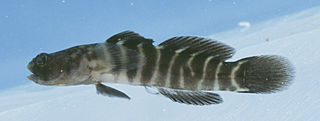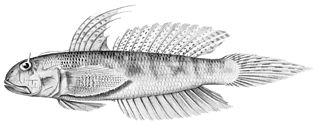
Gobiidae or gobies is a family of bony fish in the order Gobiiformes, one of the largest fish families comprising more than 2,000 species in more than 200 genera. Most of gobiid fish are relatively small, typically less than 10 cm (3.9 in) in length, and the family includes some of the smallest vertebrates in the world, such as Trimmatom nanus and Pandaka pygmaea, Trimmatom nanus are under 1 cm long when fully grown, then Pandaka pygmaea standard length are 9 mm (0.35 in), maximum known standard length are 11 mm (0.43 in). Some large gobies can reach over 30 cm (0.98 ft) in length, but that is exceptional. Generally, they are benthic or bottom-dwellers. Although few are important as food fish for humans, they are of great significance as prey species for other commercially important fish such as cod, haddock, sea bass and flatfish. Several gobiids are also of interest as aquarium fish, such as the dartfish of the genus Ptereleotris. Phylogenetic relationships of gobiids have been studied using molecular data.

Schindleria is a genus of marine fish. It was the only genus of family Schindleriidae, among the Gobioidei of order Perciformes but is now classified under the Gobiidae in the Gobiiformes. The type species is S. praematura, Schindler's fish. The Schindleria species are known generically as Schindler's fishes after German zoologist Otto Schindler (1906–1959), or infantfishes. They are native to the southern Pacific Ocean, from the South China Sea to the Great Barrier Reef off eastern Australia, and Rapa Nui.

Eleotridae is a family of fish commonly known as sleeper gobies, with about 34 genera and 180 species. Most species are found in the tropical Indo-Pacific region, but there are also species in subtropical and temperate regions, warmer parts of the Americas and near the Atlantic coast in Africa. While many eleotrids pass through a planktonic stage in the sea and some spend their entire lives in the sea; as adults, the majority live in freshwater streams and brackish water. One of its genera, Caecieleotris, is troglobitic. They are especially important as predators in the freshwater stream ecosystems on oceanic islands such as New Zealand and Hawaii that otherwise lack the predatory fish families typical of nearby continents, such as catfish. Anatomically, they are similar to the gobies (Gobiidae), though unlike the majority of gobies, they do not have a pelvic sucker.
Javelin fish, javelinfish, or javelin, may refer to several fishes:

Brachygobius is a small genus of gobies. They are popular aquarium fish where a number of species are sold as bumblebee gobies because their colours are similar to those of bumblebees.
Awaous is a genus of fish in the family Gobiidae, the gobies. They are native to fresh, marine and brackish waters from Africa to the Americas.

Mugilogobius is a genus of fish in the family Gobiidae. They are found in fresh, brackish and marine water of the Indo-Pacific region. Several of the freshwater species have highly restricted distributions.

Redigobius is a genus of fish in the goby family, Oxudercidae, known commonly as dualspot gobies. They are native to the western Indo-Pacific region, where they occur in estuaries and freshwater habitats just above the tidal influence.

Stenogobius is a genus of fish in the goby subfamily, Gobionellinae. They are native to fresh, brackish and marine waters along the coasts of the Indian and Pacific Oceans. They are known commonly as coastal stream gobies.

Elacatinus is a genus of small marine gobies, often known collectively as the neon gobies. Although only one species, E. oceanops, is technically the "neon goby", because of their similar appearance, other members of the genus are generally labeled neon gobies, as well. Except for a single East Pacific species, all reside in warmer parts of the West Atlantic, including the Caribbean and Gulf of Mexico. They are known for engaging in symbiosis with other marine creatures by providing them cleaning service that consists of getting rid of ectoparasites on their bodies. In return, Elacatinus species obtain their primary source of food, ectoparasites.

The Gobiiformes are an order of fish that includes the gobies and their relatives. The order, which was previously considered a suborder of Perciformes, is made up of about 2,211 species that are divided between seven families. Phylogenetic relationships of the Gobiiformes have been elucidated using molecular data. Gobiiforms are primarily small species that live in marine water, but roughly 10% of these species inhabit fresh water. This order is composed chiefly of benthic or burrowing species; like many other benthic fishes, most gobiiforms do not have a gas bladder or any other means of controlling their buoyancy in water, so they must spend most of their time on or near the bottom. Gobiiformes means "goby-like".

Acanthogobius is a genus of gobies native to marine, fresh and brackish waters of eastern Asia.

Ponticola is a genus of gobies native mostly to fresh waters of the Black Sea - Caspian Sea region in Eurasia. Some species occur in the brackish-water Black and Caspian seas themselves. It was considered to be part of the broader goby subfamily Benthophilinae, also endemic to the same region, although the 5th edition of Fishes of the World does not list any subfamilies in the Gobiidae. Originally, Ponticola was described as subgenus of Neogobius.

The Gobionellinae are a subfamily of fish which was formerly classified in the family Gobiidae, the gobies, but the 5th Edition of Fishes of the World classifies the subfamily as part of the family Oxudercidae. Members of Gobionellinae mostly inhabit estuarine and freshwater habitats; the main exception is the genus Gnatholepis, which live with corals in marine environments. The subfamily is distributed in tropical and temperate regions around the world with the exception of the northeastern Atlantic Ocean, the Mediterranean Sea, and the Ponto-Caspian region. It includes around 370 species and 55 genera: Wikipedia articles about genera list about 389 species.

Rhinogobiops is a genus of true gobies in the family Gobiidae. It is monotypic, being represented by the single species, Rhinogobiops nicholsii, also known as the blackeye goby, bluespot goby, and crested goby. They are common inhabitants of coral reefs and rocky habitats along the eastern Pacific Ocean coasts of Mexico, the United States, and Canada, although they are hardly noticed, as they often rest motionless near their shelters.
Chriolepis is a genus of gobies native to the Atlantic and Pacific coasts of the Americas.

Gobiosoma is a genus of gobies native to fresh, brackish and marine waters of the Americas.

Oxyurichthys is a genus of fish in the subfamily Gobionellinae, commonly known as arrowfin gobies. They are distributed in the tropical and subtropical Indian and Pacific Oceans; one species is also known from the western Atlantic Ocean. Most species live in shallow waters under 10 meters deep over fine substrates such as silt.

Goby is a common name for many species of small to medium sized ray-finned fish, normally with large heads and tapered bodies, which are found in marine, brackish and freshwater environments.















